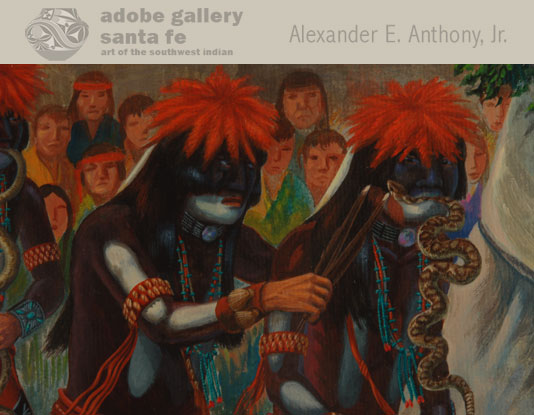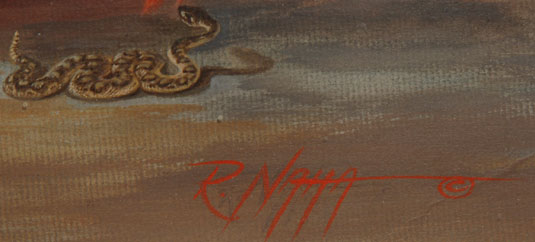Hopi Snake Dance Ceremony [SOLD]
+ Add to my watchlist Forward to Friend
- Category: Paintings
- Origin: Hopi Pueblo, Hopituh Shi-nu-mu
- Medium: Acrylic on Paper
- Size:
image: 31” x 39 ½”;
frame: 35” x 43 ¼” - Item # C4042D SOLD

Hopi-Tewa artist Raymond Naha was born on December 5, 1933 at Polacca, which is at the foot of the Hopi Reservation - First Mesa. Naha studied with celebrated Hopi painter and silversmith Fred Kabotie at Oraibi High School. Kabotie recognized the young artist’s talent and encouraged him to continue his studies. He then took correspondence courses and studied at the Phoenix Indian School.
Naha’s paintings are characterized by the accurate depiction of details of Hopi ceremonial life in a vibrant and colorful manner. His work reflects more of a European influence than other Native American painters of the time. He was one of the first to break away from the traditional Dorothy Dunn style, using diverse backgrounds and a wider variety of colors than his contemporaries.
Author and historian Erna Fergusson attended many Indian ceremonial functions in New Mexico and Arizona in the late 1920s. In the introduction to her book Dancing Gods she wrote: “An Indian dance is not a dance in the sense in which we use that term. It is a ceremonial, a symbolic representation, a prayer.” The Hopi Indians’ Snake Dance, which culminates with priests carrying snakes around the plaza in their hands and mouths, is a prayer for rain. Preparation for the Snake Dance is intensive, requiring the energy and faith of numerous participants. Those who are not directly involved participate by observing.
Naha’s extraordinary depiction of the Hopi Snake Dance Ceremony is filled will hundreds of small details, transporting the viewer to the hot August day when the ceremony occurs. Four trios of dancers are set in the foreground. Each trio consists of a carrier who is accompanied by another priest. The priest holds a snake whip feather to prevent the snake from coiling. A third priest serves the gatherer, preventing snakes from entering the crowd. Naha crafted the priests and the snakes they carry in great detail. On the rooftops behind the dancers are hundreds of observers, whose additional prayers are essential to a successful ceremony. Naha included Hopi, Navajo and Anglo observers of all shapes and sizes, accurately reflecting the diversity seen at a Hopi Snake Dance ceremony.
It is said that it often rains immediately after the Snake Dance. Above and behind the main event, Naha included a growing mass of clouds, which will hopefully bring much-needed rain to the dry Hopi mesas. Naha’s reverence for this sacred ceremony is apparent in this large, detailed and beautiful painting.
Condition: This painting of a Hopi Snake Dance Ceremony is in excellent condition
Provenance: This painting was purchased directly from the artist by its current owner, who was friends with Raymond Naha and many other Hopi Pueblo artists
Recommended Reading: DANCING GODS Indian Ceremonials of New Mexico and Arizona by Erna Fergusson

- Category: Paintings
- Origin: Hopi Pueblo, Hopituh Shi-nu-mu
- Medium: Acrylic on Paper
- Size:
image: 31” x 39 ½”;
frame: 35” x 43 ¼” - Item # C4042D SOLD



